The iPhone 12 & 12 Pro Review: New Design and Diminishing Returns
by Andrei Frumusanu on November 30, 2020 8:30 AM EST- Posted in
- Mobile
- Apple
- Smartphones
- Apple A14
- iPhone 12
- iPhone 12 Pro
Display Measurement
The new iPhone 12 and iPhone 12 Pro have on paper almost the same display characteristics, both being 6.06” OLED panels with 2532 x 1170 resolution, however they differ in their characteristics when looking at the peak maximum brightness achieved, with the regular iPhone 12 model peaking at 625 nits and the 12 Pro peaking at 800 nits.
We’re not exactly sure as to the actual manufacturing differences between the two panels, but one thing that I immediately noticed as being different between the two models is their viewing angles. The iPhone 12 showcased a larger off-axis brightness drop-off and what I would consider a more classical OLED off-axis colour tint, while the iPhone 12 Pro behaved significantly better with almost perfect off-axis brightness and colour performance. This points out to a quite different lamination process and maybe different polarisation layer between the two models.
We move on to the display calibration and fundamental display measurements of the iPhone 12 screens. As always, we thank X-Rite and SpecraCal, as our measurements are performed with an X-Rite i1Pro 2 spectrophotometer, with the exception of black levels which are measured with an i1Display Pro colorimeter. Data is collected and examined using Portrait Display's CalMAN software.
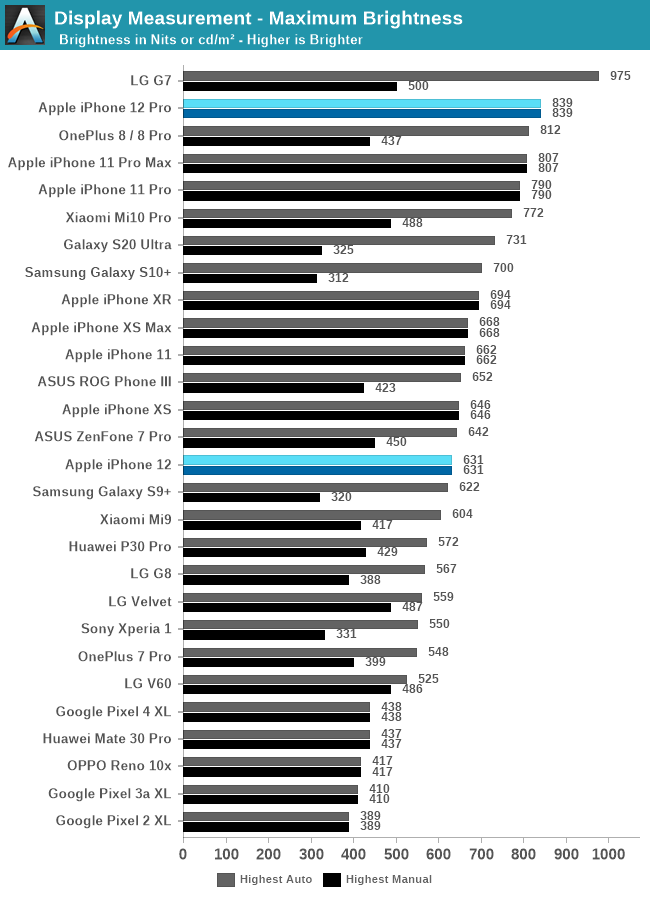
In terms of display brightness, we pretty much measure figures in line with Apple’s advertised marketing and specifications, with the new iPhone 12 reaching 631cd/m² and the iPhone 12 Pro reaching a significantly higher 839cd/m². The latter figure is the highest and brightest amongst any OLED device we’ve ever measured, although it’s not all that much brighter than the iPhone 11 Pro models.
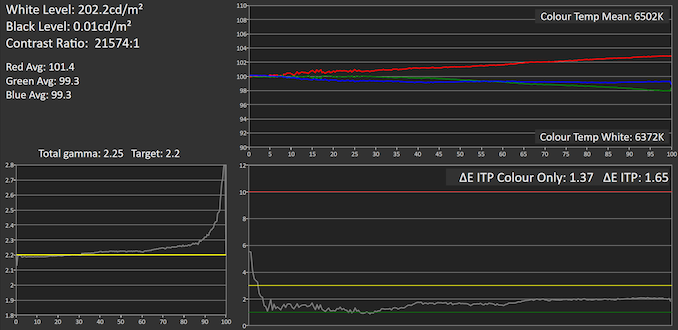
 Portrait Displays CalMAN
Portrait Displays CalMAN
iPhone 12 Pro
We start off the detailed measurements with the greyscale performance of the iPhone 12 Pro. Generally speaking, there’s very little to criticise the device here as there’s generally an excellent performance. Apple still showcases higher gamma at higher level colours, but that’s only a minor imperfection.
The white balance for whites actually is a tad warmer than it should be with some clearly higher-than-average levels of red. Although the total average white balance over all levels lands in at an excellent 6502K, actual whites land in at 6372K. It’s not an issue, but a little less perfect than we had come to expect from iPhones.
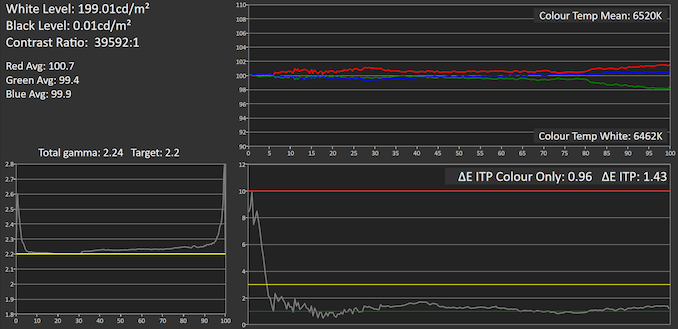
 Portrait Displays CalMAN
Portrait Displays CalMAN
iPhone 12
The iPhone 12 seems to showcase a different calibration than the 12 Pro, further evidence of the two different panels employed on the two models. The 12 seems to have slightly better gamma behaviour on the higher levels, but in exchange showcases worse off gamma at the lower levels, clipping lower level colours to black earlier than on the 12 Pro, which had near perfect behaviour here.
Oddly enough, colour temperature on the 12 behaved better than our 12 Pro sample. Average colour temperature landed in at 6520K while white landed in at 6462K, with less dominant reds than on the other phone.
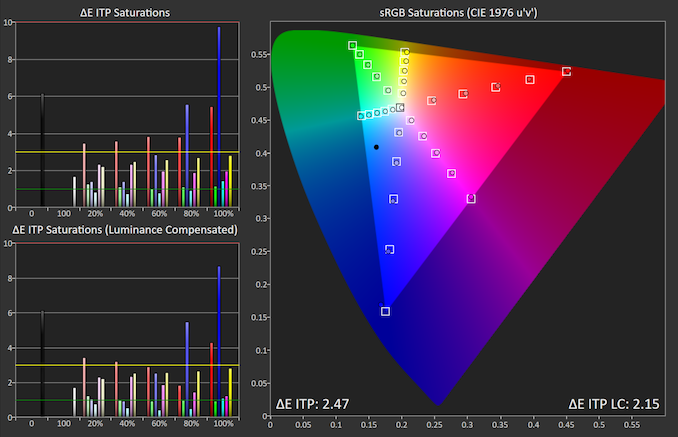 Portrait Displays CalMAN
Portrait Displays CalMAN
iPhone 12 Pro
sRGB colour saturations on the iPhone 12 Pro are quite excellent, with the biggest error margin happening at maximum saturation blues and magentas, with also a slightly oversaturated red. Below maximum intensity, the colours are all showcasing dEITP errors below 3 which is the just perceivable threshold for the average eye.
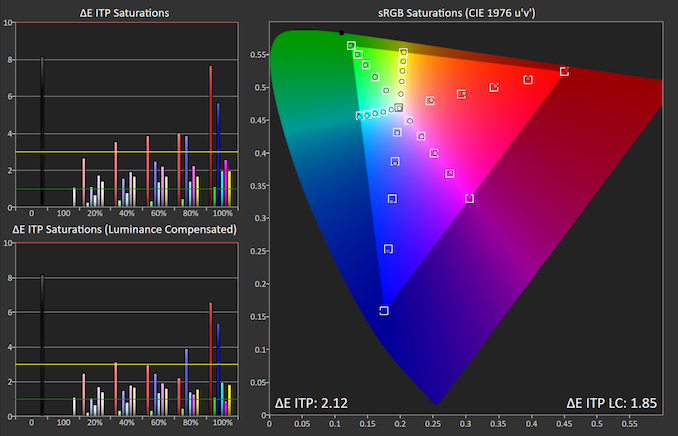 Portrait Displays CalMAN
Portrait Displays CalMAN
iPhone 12
The iPhone 12 has slightly better results, with the blue and magenta error being less pronounced on this phone. Generally it looks that our sample here is again performing a little better than our 12 Pro sample.
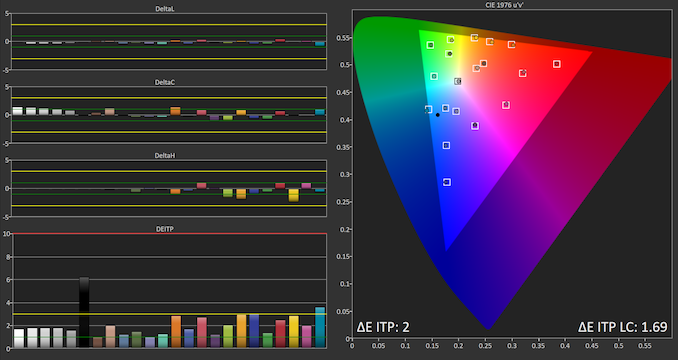
 Portrait Displays CalMAN
Portrait Displays CalMAN
iPhone 12 Pro
In our GMB chart with common colours such as skin tones, the iPhone 12 Pro behaves admirably. Given the phone’s inaccuracies seemed to be more prevalent in higher saturations in the blue and red spectrum, and this test doesn’t contain patches in that region of the gamut, it means that the remaining test colours perform extremely well.
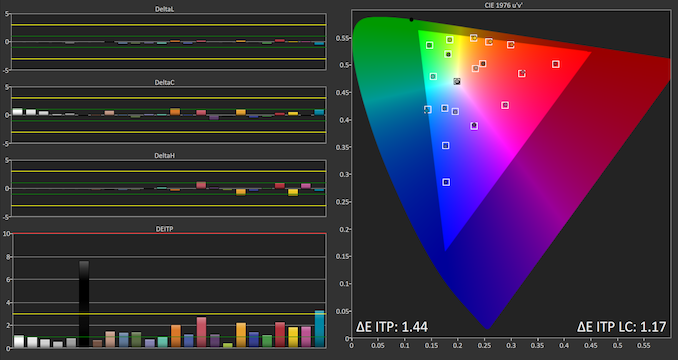
 Portrait Displays CalMAN
Portrait Displays CalMAN
iPhone 12
The iPhone 12 generally seems to beat the iPhone 12 Pro in terms of accuracy, again showcasing better results and an outstandingly good overall error result of dEITP of 1.44.
Apple Typical Best Displays
Overall, the new iPhone 12 series continues Apple’s tradition of having amongst the best calibrated displays on the market. The 12 Pro seems to just shy away from the usual Apple perfection, but the results are still outstandingly good and beyond that of any other device.
I think what’s most important for this generation of devices is the fact that the iPhone 12 now features a higher resolution OLED screen. It can’t be understated how much of an upgrade this is compared to the “Retina” grade LCD panel of the iPhone 11. Personally, this makes the iPhone 12 an actual consideration whereas I wouldn’t have been satisfied with using the iPhone 11’s LCD. It also vastly diminishes the feature gap to the Pro models – I don’t consider the brightness advantage of the 12 Pro to be all that significant, although again the Pro model does showcase better viewing angles and a more pronounced “sticker feel”.










101 Comments
View All Comments
DejayC - Monday, November 30, 2020 - link
I find the flat edges of my iPhone 12 mini to be easier to grip on to than the curved edges of the older iPhones.FunBunny2 - Monday, November 30, 2020 - link
I was just about to post just that. could it be that short people with small hands are the only ones to complain about flat edged phones (and other things)? those for 4 edges, intelligently chamfered of course, are what give you purchased to hold on to that slippery thing.jeremyshaw - Monday, November 30, 2020 - link
I think completely flat edges work better on smaller phones. Mini, 5, 5S, 5C, etc. 4 and 4S as well. Though the 4 and 4S were "technically" flat, they did have the actual back and screen protruding enough to be a stepped approximation of a curved edge.xaneo - Saturday, December 26, 2020 - link
I'm jumping onto the flat edges bandwagon, all for it.milkywayer - Wednesday, December 2, 2020 - link
I still don't understand what makes the iPhone 12 worth ~$850 after tax compared to iPhone 11 that apples website is selling for $640~? Can someone explain?My biggest gripe with iOS is it kills my previous app pretty fast e.g. I could be watching YouTube or browsing a chrome tab but if I switch to reddit and or then whatsapp and then come back to the chrome or youtube, it'll make likely reload the entire app/page and I lose my progress.
I got tired of the small keyboard on my 2020 iphone SE and was going back and forth between picking iPhone 11 vs iPhone 12 and when I realized the 13 still has the same 4gb RAM, it was an easy decision going for the iphone 11 as both have the same display size and except for the tiny bit faster cpu which I probably wouldn't have noticed browsing chrome or reddit and the oled screen which isn't a big deal.
I couldn't justify spending almost 35-40% more for a tiny tiny upgrade.
What I would love for would be to get a bigger screen size like the pro max but apple has prices those out of my budget and most people's budgets I'd assume.
Frantisek - Friday, December 4, 2020 - link
I guess very durable screen on 12 can pay for itself.Speedfriend - Sunday, December 6, 2020 - link
Your point about iOS is one of the main reasons I don't use an iPhone. I day trade and iOS suspending apps in the background means that I have switched quickly to a trading app to check prices not realising they are totally out of date. Totally uselessblackcrayon - Thursday, December 10, 2020 - link
That sounds like that particular app doesn't work properly. Apps can refresh in the background, but even if not, why would it take more than a second to update from waking a suspended app?ZGamer - Monday, December 7, 2020 - link
12 Pro models ship with 6GB ram vs 4GB.As with everything it depends on which models your looking and how your looking to buy. If looking at purchasing outright for some of the mvno carriers or prepaid service the 11 is a better deal. If looking at deals with bill pay credits and other incentives it can be very cheap to get a 12.
Sales around Black Friday had the iPhone 12 for free with qualifying trade and bill pay credits....12 Pro for $99 and 12 Pro Max for $199 if you had the right set of circumstances (new line/port-in only for AT&T and Best Buy).
In general year or year performance gains are generally pretty small, it's the two to five year old devices that can see larger performance improvements.....and a fresh battery.
ebernet - Wednesday, December 9, 2020 - link
@milkywayer these are some of the reasons that would lead me to pick a 12 over an 11...1. The iPhone 11 is an LCD screen instead of OLED, with a 2x Retina display and 1792‑by‑828‑pixel resolution at 326 ppi. The 12 is OLED with a 3 pixel per point for 2532-by-1170-pixel resolution at 460 ppi. The OLED allows the screen to be closer to the edge. I would think that is the biggest reason.
2. Significantly better night mode
3. Only 32% more, not 35-40
There are a bunch of other reasons to choose the 12 over the 11, but for me the change from LCD to OLED at MUCH higher pixel resolution and a more durable screen is sufficient.
That being said, I am still on my XS Max and will be waiting for the 13. There were days when I would upgrade my iPhone EVERY year (original all the way through the 4S). As the curve of improvements slowed down I went to every other year (5S, 6S Plus). Now I am on a 3 year tick and the XS Max is plenty good enough for me. I am looking forward to HOPEFULLY some kind of better optical zoom in the iPhone 13. However, if this was my tock year I'd be going for a 12 Pro Max with 256, but if I had to choose between an 11 and a 12 it would be a NO brainer, much more than last year choosing between the 11 and the XR (much more of a valid comparison because they both shared very similar screens). The screen on the 12 is on its own worth the price delta between the 12 and 11.